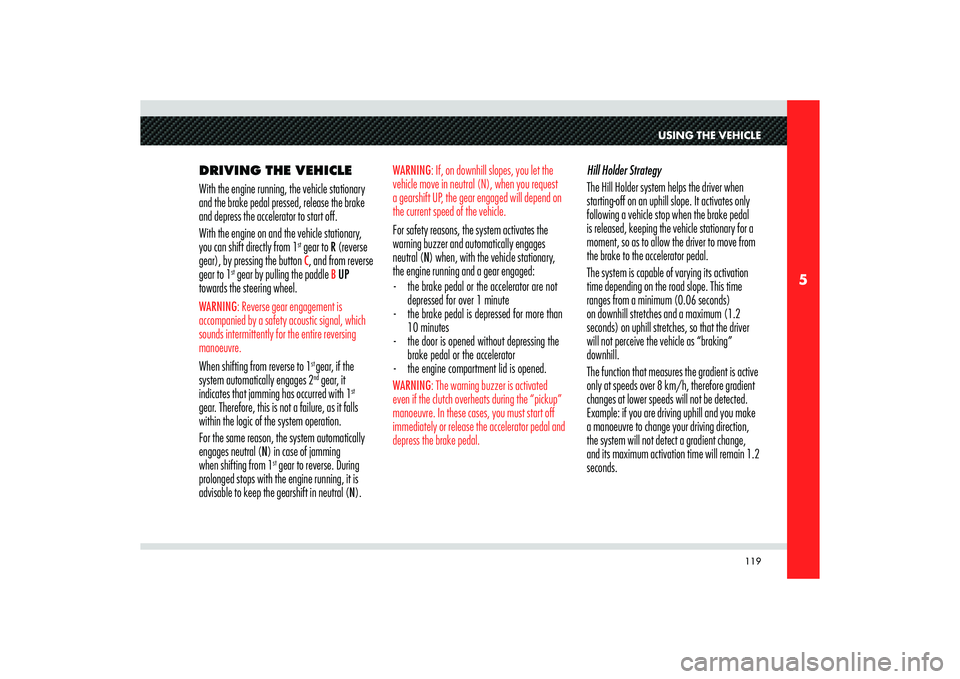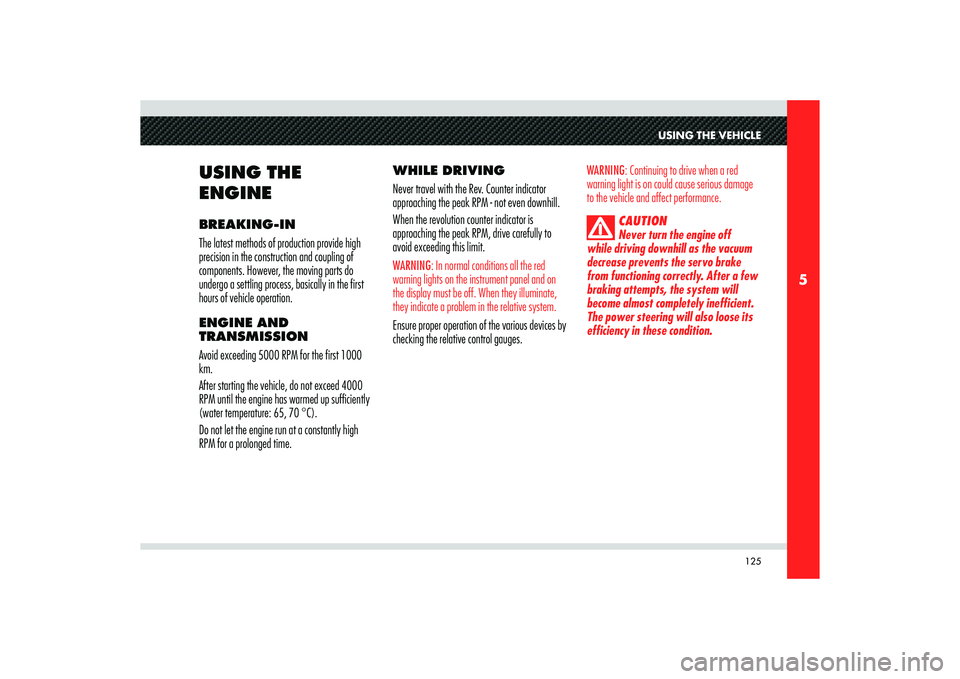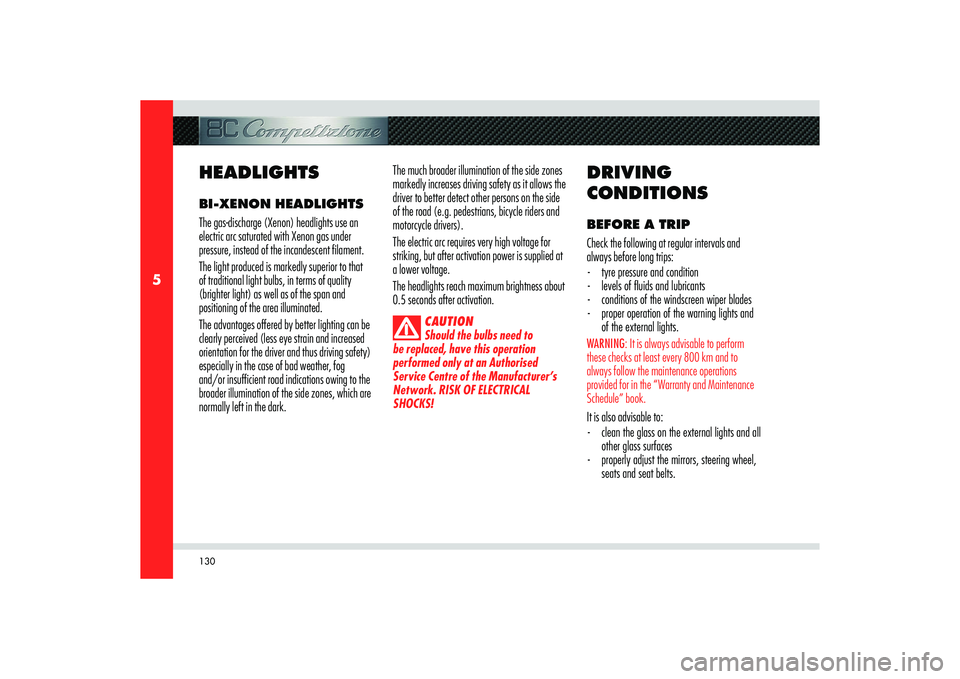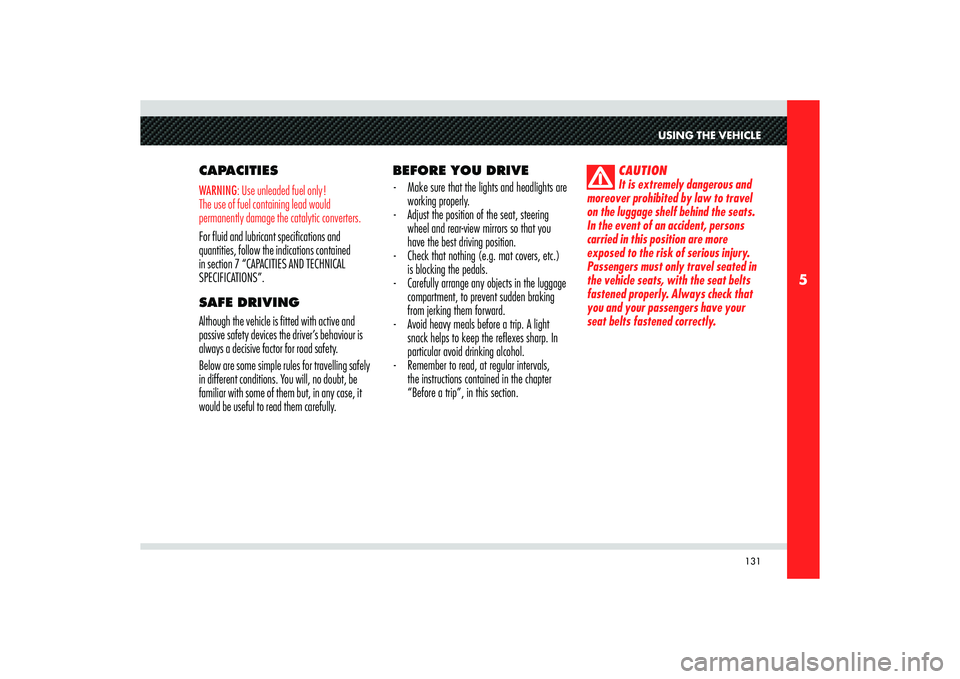warning Alfa Romeo 8C 2008 Owner handbook (in English)
[x] Cancel search | Manufacturer: ALFA ROMEO, Model Year: 2008, Model line: 8C, Model: Alfa Romeo 8C 2008Pages: 223, PDF Size: 14.35 MB
Page 121 of 223

119
5
USING THE VEHICLE
DRIVING THE VEHICLE
With the engine running, the vehicle stationary
and the brake pedal pressed, release the brake
and depress the accelerator to start off.
With the engine on and the vehicle stationary,
you can shift directly from 1
st gear to R (reverse
gear), by pressing the button C, and from reverse
gear to 1
st gear by pulling the paddle
B UP
towards the steering wheel.
WARNING: Reverse gear engagement is
accompanied by a safety acoustic signal, which
sounds intermittently for the entire reversing
manoeuvre. When shifting from reverse to 1
st gear, if the
system automatically engages 2nd gear, it
indicates that jamming has occurred with 1
st
gear. Therefore, this is not a failure, as it falls
within the logic of the system operation.
For the same reason, the system automatically
engages neutral (N) in case of jamming
when shifting from 1
st gear to reverse. During
prolonged stops with the engine running, it is
advisable to keep the gearshift in neutral (N).Hill Holder Strategy
The Hill Holder system helps the driver when
starting-off on an uphill slope. It activates only
following a vehicle stop when the brake pedal
is released, keeping the vehicle stationary for a
moment, so as to allow the driver to move from
the brake to the accelerator pedal.
The system is capable of varying its activation
time depending on the road slope. This time
ranges from a minimum (0.06 seconds)
on downhill stretches and a maximum (1.2
seconds) on uphill stretches, so that the driver
will not perceive the vehicle as “braking”
downhill.
The function that measures the gradient is active
only at speeds over 8 km/h, therefore gradient
changes at lower speeds will not be detected.
Example: if you are driving uphill and you make
a manoeuvre to change your driving direction,
the system will not detect a gradient change,
and its maximum activation time will remain 1.2
seconds.
WARNING: If, on downhill slopes, you let the
vehicle move in neutral (N), when you request
a gearshift UP, the gear engaged will depend on
the current speed of the vehicle. For safety reasons, the system activates the
warning buzzer and automatically engages
neutral (N) when, with the vehicle stationary,
the engine running and a gear engaged:
- the brake pedal or the accelerator are not
depressed for over 1 minute
- the brake pedal is depressed for more than
10 minutes
- the door is opened without depressing the
brake pedal or the accelerator
- the engine compartment lid is opened.WARNING: The warning buzzer is activated
even if the clutch overheats during the “pickup”
manoeuvre. In these cases, you must start off
immediately or release the accelerator pedal and
depress the brake pedal.
Page 124 of 223

122
5
OTHER SYSTEM
FUNCTIONS
“Low-grip” WET mode
This mode can be used on particularly slippery
road surfaces (e.g., snow, ice) and it is
activated/deactivated by pressing button
E.
This will light up the letter “W” on the instrument
panel display.
While driving, the system ignores any
gearshifting which would cause RPM adjustment
above 2800 RPM.
“Low-grip” mode has priority over the other
functions (“automatic gearshift” and “SPORT”)
and it assists the VDC system.It is always a good rule to deactivate the other
operating modes (“automatic gearshift” and
“SPORT”) before you select “low-grip” mode.
“Automatic gearshift” mode AUTO
It is activated/deactivated by pressing the
button
D; the gear displayed is replaced with the
letter “D” and the system will automatically shift
the gears UP and DOWN according to the vehicle
speed, the engine RPM and the torque/power
requested by the driver.
WARNING: The “automatic gearshift” mode has
priority over “SPORT” mode. Therefore, if you
press the AUTO button, D the system will operate
in “automatic gearshift” mode.You can go back to NORMAL mode (or SPORT
mode, if this was active) by holding the button
D
pressed down until the word AUTO goes off.When the vehicle is stationary, requesting N 1
st
or R will not cause the system to switch from
“Automatic gearshift” to “Normal” mode.
It is always a good rule to deactivate the other
operating modes before you select “Automatic
gearshift” mode.
“No auto exit” strategy
In AUTO mode you can always request
a gearshift using the paddles, which will
temporarily set the system to “manual” mode.
This is shown on the display by the word “AUTO”
that flashes for 5 seconds and then illuminates
permanently, thus confirming that the system
has returned to AUTO mode. A further gearshift
request will restart the 5-second timer.
E
D
Page 125 of 223

123
5
F
USING THE VEHICLE
“SPORT” mode
It is activated by pressing button
F; the letter “S”
will illuminate on the display.
To return to “NORMAL” mode from “SPORT”
mode, press the button again.
As “SPORT” mode has lower priority over “low-
grip” and “automatic gearshift” modes, if these
are already active when you activate “SPORT”
mode, the system will ignore the command even
though the relative warning light switches on.
CAUTION
“SPORT” mode is characterised
by faster gearshifts than in
“NORMAL” mode and engine power
reduction through the ASR system is
kept to a minimum.
Fast gearshifting however always depends on
the accelerator pedal travel and on the engine
RPM, as in “NORMAL” mode.
DOWNshifts with the accelerator pedal released,
will have a braking effect approaching the
skidding of the driving wheels on dry asphalt.
Under racing-style driving conditions with
gearshifts at high engine RPM, double-clutching
when up-shifting is performed automatically.
CAUTION
It is advisable not to use
“SPORT” mode on roads with low or
medium “grip” conditions (e.g. ice,
snow, or wet roads) as the driving
wheels could skid during gearshifts.
Therefore, excessive use of the vehicle
in “SPORT” mode is advisable only on
racetracks.
If you use a racing-style driving when starting-off
or gearshifting with SPORT mode active, you
might feel the driving wheels begin to slip even
on dry roads.
It is a good rule to deactivate the other operating
modes (“low-grip” and “automatic gearshift”)
before you select “SPORT” mode.
Page 126 of 223

124
5
WARNING: In the event that the control lever
assembly is malfunctioning, in addition to
activating the buzzer and the failure warning
light
, the system enables “automatic
gearshift” mode and any gearshift command,
including the request for N and R, will be
ignored.
WARNING: If the malfunction persists,
contact an Authorised Service Centre of the
Manufacturer’s Network as soon as possible to
have the malfunction corrected.
PUSH START
In the case of malfunctioning of the starter
system, you can push-start the vehicle
proceeding as follows
- perform the “system start-up” stage
- request UP while the vehicle is picking up
speed with the gearbox in N.WARNING: This procedure should not be used
unless there is an emergency situation!
USING THE
BRAKESTo allow the brake pads and discs to run in
properly, avoid sudden braking during the first
300 km.
The ABS is a component of the braking system
that provides two basic advantages:
- It avoids locking of the wheels and thus
skidding during emergency braking,
especially under low grip conditions.
- It makes it possible to brake and steer at
the same time in order to avoid unexpected
obstacles or to direct the vehicle where
desired when braking: this is in keeping
with the physical limits of the tyre side grip. In order to fully exploit the ABS:
- You will note a light vibration of the brake
pedal during emergency braking or braking
under low grip conditions: This indicates
that the ABS is operating. Do not release
the pedal but continue to press it to give
continuity to the braking action.
- The ABS prevents the wheels from locking,
but it does not increase the physical grip
limits between the tyres and the road.
So, even with vehicles equipped with
ABS, always ensure that you keep to a
safe distance from the vehicle in front and
reduce your speed when entering a bend.
Page 127 of 223

125
5
USING THE VEHICLE
USING THE
ENGINEBREAKING-IN
The latest methods of production provide high
precision in the construction and coupling of
components. However, the moving parts do
undergo a settling process, basically in the first
hours of vehicle operation.
ENGINE AND
TRANSMISSION
Avoid exceeding 5000 RPM for the first 1000
km.
After starting the vehicle, do not exceed 4000
RPM until the engine has warmed up sufficiently
(water temperature: 65, 70 °C).
Do not let the engine run at a constantly high
RPM for a prolonged time.WHILE DRIVING
Never travel with the Rev. Counter indicator
approaching the peak RPM - not even downhill.
When the revolution counter indicator is
approaching the peak RPM, drive carefully to
avoid exceeding this limit.
WARNING: In normal conditions all the red
warning lights on the instrument panel and on
the display must be off. When they illuminate,
they indicate a problem in the relative system.Ensure proper operation of the various devices by
checking the relative control gauges.
WARNING: Continuing to drive when a red
warning light is on could cause serious damage
to the vehicle and affect performance.
CAUTION
Never turn the engine off
while driving downhill as the vacuum
decrease prevents the servo brake
from functioning correctly. After a few
braking attempts, the system will
become almost completely inefficient.
The power steering will also loose its
efficiency in these condition.
Page 128 of 223

126
5
Engine control system (EOBD)
The EOBD (European On Board Diagnosis)
system fitted on the vehicle is compliant with the
2003/76B/EC Directive (EURO 4).
This system continuously monitors the
components of the vehicle related to emissions;
it also indicates, when the warning light
illuminates on the instrument panel, that the
components in question are in poor condition.
The objective is the following:
- monitor the system effi ciency
- indicate when a problem causes an
increase in emissions exceeding the limits
established by European regulations
- indicate the need for replacement of worn
components.In addition, the system includes a diagnostics
connector that can be interfaced with suitable
instruments. This makes it possible to read the
error codes stored in the control unit, together
with a set of specific parameters for engine
operation diagnostics.
WARNING: If when turning the ignition key
to MARthe warning light
does not
illuminate or if it illuminates while driving,
contact an Authorised Service Centre of the
Manufacturer’s Network as soon as possible.
WARNING: After correcting the malfunction, the
entire system must be tested by the personnel
of an Authorised Service Centre of the
Manufacturer’s Network that must perform
tests on the bench and, if necessary, the road
test the vehicle: this might require travelling long
distances.
CONSTANT SPEED
REGULATOR (CRUISE CONTROL)GENERAL
The Cruise Control function allows the driver
to maintain the desired vehicle speed constant
without pressing the accelerator pedal. This
reduces driver fatigue on highways, especially
long trips, as the set speed is automatically
maintained.WARNING: The device can only be activated at
speeds exceeding 30 km/h and it deactivates
automatically when the brake pedal is
depressed.
Page 129 of 223

127
5
A
B
C
USING THE VEHICLE
CAUTION
Cruise Control must only
be activated when traffic and the
route permit a constant speed to be
maintained safely, for a sufficiently
long distance.
CONTROLS
The Cruise Control function is controlled by
means of the switch
A, the dial
B and the button
C (RCL).
Switch
A can be set to two positions:
- OFF the device is deactivated;
- ON the device is active. When the device
is activated, the symbol
illuminates on
the instrument panel display.The dial
B is used to store and maintain the
vehicle speed, or to increase or decrease the
speed stored.
Rotate the dial
B to position (+) to save the
speed reached or to increase the speed stored.
Rotate the dial B to position (–) to decrease the
stored speed.
Each turn of the dial
B increases or decreases the
speed by about 1 km/h. Rotate and hold the
dial to vary the speed continuously. When a new
speed is reached, it will automatically remain
constant.
Button
C (RCL) allows you to reset the stored
speed.
WARNING: When the ignition key is turned to
position STOP or the switch A to position OFF,
the stored speed is deleted and the system
deactivated.STORING A SPEED
Set the switch
A to ON and bring the vehicle up
to the desired speed. Rotate the dial
B to (+)
for at least three seconds, then release it. The
vehicle speed is saved and the accelerator pedal
can then be released.
The vehicle will proceed at the constant speed
stored in the memory until the brake pedal is
pressed.
If necessary, (for example, to pass another
vehicle), you can accelerate by simply pressing
the accelerator pedal. Afterwards, when you
release the accelerator pedal, the vehicle will
return to the speed saved previously.
Page 132 of 223

130
5
HEADLIGHTSBI-XENON HEADLIGHTS
The gas-discharge (Xenon) headlights use an
electric arc saturated with Xenon gas under
pressure, instead of the incandescent filament.
The light produced is markedly superior to that
of traditional light bulbs, in terms of quality
(brighter light) as well as of the span and
positioning of the area illuminated.
The advantages offered by better lighting can be
clearly perceived (less eye strain and increased
orientation for the driver and thus driving safety)
especially in the case of bad weather, fog
and/or insufficient road indications owing to the
broader illumination of the side zones, which are
normally left in the dark.The much broader illumination of the side zones
markedly increases driving safety as it allows the
driver to better detect other persons on the side
of the road (e.g. pedestrians, bicycle riders and
motorcycle drivers).
The electric arc requires very high voltage for
striking, but after activation power is supplied at
a lower voltage.
The headlights reach maximum brightness about
0.5 seconds after activation.
CAUTION
Should the bulbs need to
be replaced, have this operation
performed only at an Authorised
Service Centre of the Manufacturer’s
Network. RISK OF ELECTRICAL
SHOCKS!
DRIVING
CONDITIONSBEFORE A TRIP
Check the following at regular intervals and
always before long trips:
- tyre pressure and condition
- levels of fl uids and lubricants
- conditions of the windscreen wiper blades
- proper operation of the warning lights and
of the external lights.WARNING: It is always advisable to perform
these checks at least every 800 km and to
always follow the maintenance operations
provided for in the “Warranty and Maintenance
Schedule” book.It is also advisable to:
- clean the glass on the external lights and all
other glass surfaces
- properly adjust the mirrors, steering wheel,
seats and seat belts.
Page 133 of 223

131
5
USING THE VEHICLE
CAPACITIESWARNING: Use unleaded fuel only!
The use of fuel containing lead would
permanently damage the catalytic converters.For fluid and lubricant specifications and
quantities, follow the indications contained
in section 7 “CAPACITIES AND TECHNICAL
SPECIFICATIONS”.
SAFE DRIVING
Although the vehicle is fitted with active and
passive safety devices the driver’s behaviour is
always a decisive factor for road safety.
Below are some simple rules for travelling safely
in different conditions. You will, no doubt, be
familiar with some of them but, in any case, it
would be useful to read them carefully.BEFORE YOU DRIVE
- Make sure that the lights and headlights are
working properly.
- Adjust the position of the seat, steering
wheel and rear-view mirrors so that you
have the best driving position.
- Check that nothing (e.g. mat covers, etc.)
is blocking the pedals.
- Carefully arrange any objects in the luggage
compartment, to prevent sudden braking
from jerking them forward.
- Avoid heavy meals before a trip. A light
snack helps to keep the refl exes sharp. In
particular avoid drinking alcohol.
- Remember to read, at regular intervals,
the instructions contained in the chapter
“Before a trip”, in this section.
CAUTION
It is extremely dangerous and
moreover prohibited by law to travel
on the luggage shelf behind the seats.
In the event of an accident, persons
carried in this position are more
exposed to the risk of serious injury.
Passengers must only travel seated in
the vehicle seats, with the seat belts
fastened properly. Always check that
you and your passengers have your
seat belts fastened correctly.
Page 135 of 223

133
5
USING THE VEHICLE
- Use the high beams only outside of urban
areas and when you are sure that they will
not disturb other drivers.
- When another vehicle is approaching,
switch the high beams (if on) to low
beams.
- Keep the lights and headlights clean.
- Outside urban areas, beware of animals
crossing the road. DRIVING IN THE RAIN
Rain and wet roads are dangerous. On a wet
road all the manoeuvres are more difficult since
wheel grip on the asphalt is significantly reduced.
This means that the braking distances increase
considerably and the road holding decreases.
Certain advice for driving in the rain follows:
- Reduce your speed and keep a greater
safety distance from the vehicles in front
of you. High speed may result in a loss of
control and aquaplaning.
- Heavy rain also substantially reduces
visibility.
- Set the Air Conditioning controls to
demisting, in order to avoid any visibility
problems.
- Periodically check the conditions of the
windscreen wiper blades. DRIVING IN FOG
If the fog is dense avoid travelling where
possible.
When driving in mist, blanket fog or when there
is the possibility of banks of fog:
- Keep a moderate speed.
- Turn on the rear fog lights. Do not use the
main beam.
- Remember that fog creates dampness on
the asphalt and thus any type of manoeuvre
is more diffi cult and braking distances are
greater.
- Keep a safe distance from the vehicle in
front of you.
- Avoid sudden changes in speed as much as
possible.
- Whenever possible, avoid passing other
vehicles.
- If you are forced to stop the vehicle
(breakdowns, impossibility of proceeding
due to poor visibility, etc.), fi rst of all, try to
stop off of the travel lane. Then turn on the
hazard warning lights and if possible, the
low beams.